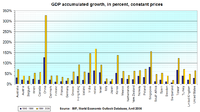
Photo from wikipedia
To study the economic and environmental effects of human capital, previous studies measure human capital based on education; however, this approach has many shortcomings because not all educated people are… Click to show full abstract
To study the economic and environmental effects of human capital, previous studies measure human capital based on education; however, this approach has many shortcomings because not all educated people are innovative human capital. Hence, this study introduces the concept of innovative human capital by developing a new index that measures human capital based on the number of patents every one million R&D staff full-time equivalent. After this, this paper studies the impact of innovative human capital on CO2 emissions in China. The provincial panel data of 30 Chinese provinces from 2003 to 2017 is analyzed using the fixed effect, ordinary least squares, and the system generalized method of moments (SYS-GMM). The analysis revealed that innovative human capital alleviates environmental deterioration in China. The findings unfold the existence of the environmental Kuznets curve (EKC) considering innovative human capital in the model. It implies that Chinese economic development will eventually support environmental sustainability if China continues to develop its innovative human capital. Among the control variables, economic structure, population density, and energy intensity stimulate environmental degradation by increasing CO2 emissions. However, FDI has a negative relationship with CO2 emissions. Lastly, the study proposes comprehensive policies to increase innovative human capital for environmental sustainability.
Journal Title: International Journal of Environmental Research and Public Health
Year Published: 2021
Link to full text (if available)
Share on Social Media: Sign Up to like & get
recommendations!